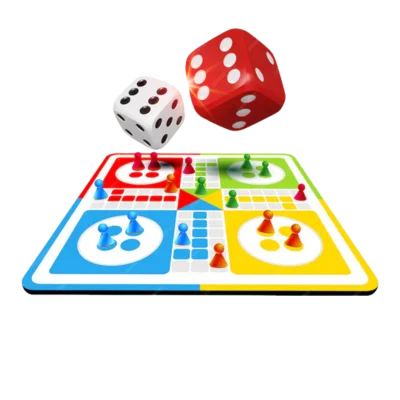Introduction
Ludo has remained a popular game across generations, and its transition into the digital world has further expanded its reach. As mobile gaming continues to dominate the entertainment industry, understanding the demographics of Ludo game users is essential for developers, marketers, and gaming platforms to optimize user experience, tailor marketing strategies, and maximize engagement. In this blog, we will explore the age, gender, geographical distribution, user behavior, and preferences of Ludo game players worldwide.

1. Age Distribution of Ludo Game Players
Ludo games attract players from various age groups, each engaging with the game for different reasons.
1.1 Young Adults (18-25 years): The Social Gaming Enthusiasts
A significant percentage of Ludo players belong to the 18-25 age group. For this demographic, Ludo serves as:
- A quick and engaging casual game that fits into busy schedules.
- A social platform to connect with friends and family through online multiplayer modes.
- A competitive gaming experience, with tournaments and leaderboards keeping them engaged.
🔹 Example: Many university students play Ludo games in their free time, often engaging in friendly competitions via multiplayer modes.
1.2 Middle-Aged Players (25-45 years): The Competitive & Strategic Gamers
This age group plays Ludo as:
- A stress reliever after work or during free time.
- A nostalgic activity, reconnecting with childhood memories.
- A skill-based competition, particularly in real-money Ludo gaming platforms.
🔹 Example: Working professionals often engage in Ludo tournaments for real-money winnings or leaderboard rankings.
1.3 Older Adults (45+ years): The Nostalgic & Relaxation Gamers
Ludo has witnessed a rise in players aged 45 and above, particularly during the COVID-19 lockdown when many sought online entertainment.
Why do older adults play Ludo games?
- It evokes childhood nostalgia, making it an appealing pastime.
- The simple mechanics and easy learning curve make it accessible.
- It allows them to connect with younger family members through online play.
🔹 Example: A retiree enjoys playing Ludo as part of their daily routine, reconnecting with old friends through multiplayer games.
2. Gender Distribution of Ludo Game Players
Ludo is one of the few mobile games that enjoys gender diversity in its player base. Unlike traditional online games that tend to have a male-dominated audience, Ludo games attract both men and women equally, as the game is:
- Simple and intuitive, making it easy for all players to enjoy.
- Social and interactive, offering an opportunity for family and friends to bond.
- Culturally familiar, particularly in South Asian and Middle Eastern countries, where board games are popular in households.
🔹 Example: A mother and her children engage in online Ludo games as a fun family activity.
3. Geographical Distribution of Ludo Players

3.1 India: The Largest Market for Ludo Games
India accounts for a majority of the global Ludo game audience, with nearly 79% of Ludo players originating from the country.
Reasons for Ludo’s Popularity in India:
- The game has strong cultural roots and is widely played in Indian households.
- Mobile gaming adoption has increased, especially in tier-2 and tier-3 cities.
- Affordable internet access and smartphone penetration have driven gaming adoption.
🔹 Example: Indian gaming companies often localize Ludo games with regional themes, Hindi/vernacular language support, and festive tournaments to appeal to the local audience.
3.2 International Reach: Expanding Beyond India
While India dominates the Ludo gaming market, the game has gained traction in other regions as well, including:
- Indonesia & Pakistan – Strong cultural affinity for board games.
- Nepal & Bangladesh – High engagement in multiplayer and real-money Ludo.
- Saudi Arabia & UAE – Expanding mobile gaming industry.
- Brazil & Latin America – Growing interest in digital board games.
🔹 Example: A Ludo gaming platform expanding globally introduces new language options to cater to a broader audience.
4. User Behavior & Gaming Preferences

4.1 Nostalgia and Social Interaction: The Driving Forces
Many players engage with Ludo games due to nostalgia and the ability to socialize with friends and family.
Why do people love Ludo?
- Nostalgic appeal – Reminds players of their childhood board game experiences.
- Multiplayer modes – Allows online gaming with family members from different locations.
- Easy to learn, hard to master – Simple gameplay mechanics but competitive strategies.
🔹 Example: A group of friends who once played physical Ludo as kids now play online Ludo together despite living in different cities.
4.2 COVID-19 & The Rise of Online Ludo Gaming
The COVID-19 pandemic played a key role in Ludo’s digital resurgence. During lockdowns, online Ludo games:
- Saw a massive increase in daily active users.
- Became a preferred mode of entertainment for many people stuck at home.
- Helped players stay connected socially despite physical distancing.
🔹 Example: Ludo King, one of the most popular Ludo apps, experienced a record-breaking surge in downloads during the pandemic.
5. Marketing & Game Development Strategies Based on Demographics
5.1 Localized Content for Different Markets
India & South Asia – Implement regional themes and language support.
Middle East – Introduce premium subscription models for high-value players.
Western Markets – Focus on social gaming elements and NFT-based customization.
5.2 Gamification Features for Different Age Groups
Young Adults (18-25 years): Competitive tournaments, leaderboards, and referral bonuses.
Middle-Aged Players (25-45 years): Real-money Ludo matches, premium in-game items.
Older Adults (45+ years): Simple UI, offline mode, and casual play options.
5.3 Social Engagement & Community Building
Encourage user retention with social incentives (friend invites, team-based tournaments).
Create an online community for Ludo enthusiasts to share experiences, tips, and updates.
🔹 Example: A Ludo gaming company introduces a special tournament for older players, allowing them to compete in a low-intensity gaming environment.
Unveil Excellence with Our Top-Tier Ludo Game Development Company

Conclusion
Ludo games attract a diverse audience across different age groups, genders, and global regions. Ludo game development companies In 2025 can leverage user demographics, behavior, and preferences to:
- Optimize game design for different player segments.
- Create targeted marketing campaigns to drive engagement.
- Expand into new geographical markets with localized content.
The continued evolution of multiplayer features, gamification strategies, and real-money gaming elements will further drive the popularity and profitability of Ludo games worldwide Game development Company.














